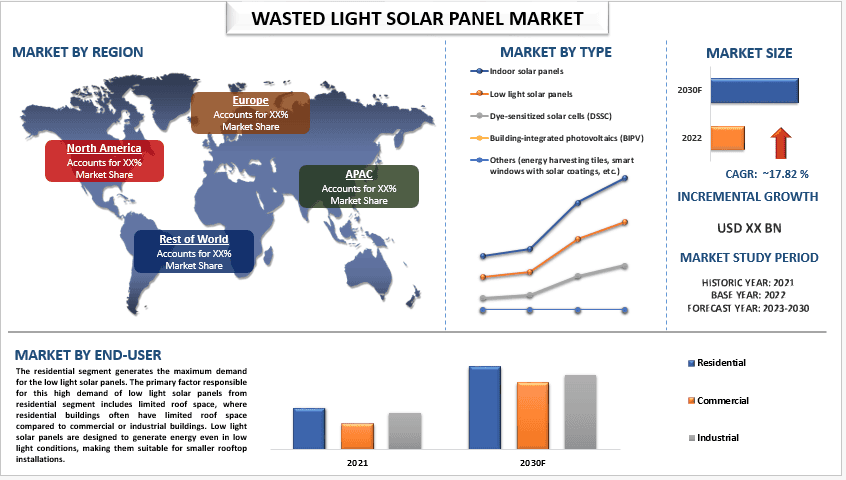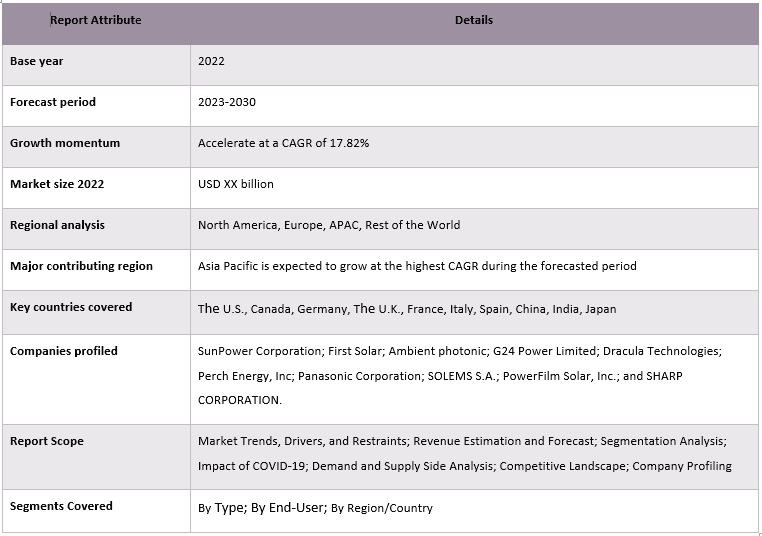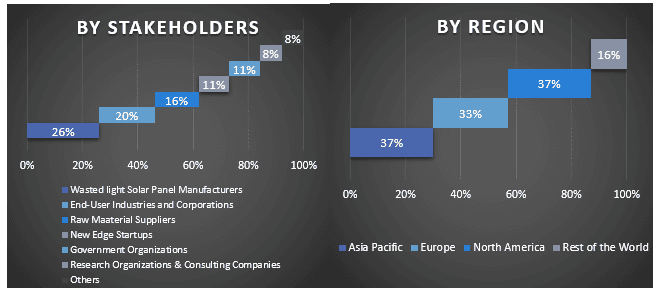無駄光太陽光パネル市場:現在の分析と予測(2023年~2030年)
タイプ別(屋内ソーラーパネル、低照度ソーラーパネル、色素増感太陽電池(DSSC)、ビル一体型太陽光発電(BIPV)、その他(エネルギーハーベスティングタイル、ソーラーコーティングを施したスマートウィンドウなど))、エンドユーザー産業別(住宅、商業、工業)、および地域/国別

Wasted Light Solar Panel Market(無駄光太陽光パネル市場)は、2022年にX0億ドルの評価額となり、再生可能エネルギー資源の採用の急増とエネルギー生成の持続可能なソリューションへの投資の増加により、予測期間(2023年から2030年)中に約17.82%の力強い成長率で成長すると予想されています。低照度太陽光パネルのトラクションが高まっている主な理由は、低照度太陽光パネルが曇り空、日陰の場所、さらには屋内照明などの周囲光からエネルギーをより効率的かつ効果的に利用できるように設計されていることが挙げられます。そのため、曇りの日が多い地域、日照時間が短い地域、または直射日光が当たらない場所で有利になります。さらに、低照度太陽光パネルの背後にある技術には、アモルファスシリコンや薄膜太陽電池などの高度な半導体材料の使用が含まれており、これらの材料はより広いスペクトルの光の波長に対してより高い感度を持っています。これらの材料により、パネルは赤外線や紫外線など、低照度の条件でも豊富な、利用可能な光スペクトルのより広い範囲を捕捉して変換できます。このような要因が、市場における低照度または周囲光太陽光パネルの成長に貢献しており、このような要因により、この分野では一連の投資と製品発売が起きています。例えば、ChiconyとAmbient Photonicsは、アンビエントの低照度太陽光発電セルを動力源とするバッテリーフリーのワイヤレスキーボードを開発するための提携を発表しました。
市場で事業を展開している主要なプレーヤーには、SunPower Corporation、First Solar、Ambient photonic、G24 Power Limited、Dracula Technologies、Perch Energy, Inc、Panasonic Corporation、SOLEMS S.A.、PowerFilm Solar, Inc.、SHARP CORPORATIONなどがあります。これらのプレーヤーは、ハイテクで革新的な製品/テクノロジーで顧客を容易にするために、いくつかのM&Aとパートナーシップを実施しています。
レポートで提示された洞察
「タイプ別では、色素増感太陽電池(DSSC)セグメントが2022年の市場の大きなシェアを占めました。」
タイプに基づいて、市場は屋内太陽光パネル、低照度太陽光パネル、色素増感太陽電池(DSSC)、建物一体型太陽光発電(BIPV)、およびその他(エネルギーハーベスティングタイル、太陽光コーティングされたスマートウィンドウなど)にセグメント化されています。色素増感太陽電池(DSSC)は、低照度太陽光パネル市場の大部分を占めています。この支配的な地位を占める主な要因には、効率があり、DSSCは従来のシリコンベースの太陽電池に匹敵する高い電力変換効率を示しています。さらに、DSSCは、低照度や屋内環境など、さまざまな照明条件下で動作できます。この汎用性により、携帯型電子機器、建物一体型太陽光発電、さらには衣類など、幅広い用途に適しています。さらに、DSSCは、比較的単純な製造プロセスにより、大規模生産の可能性を提供します。再生可能エネルギーの需要が拡大し続けるにつれて、生産規模を拡大し、コストをさらに削減する機会があります。
「エンドユーザー産業別では、住宅セグメントが予測期間(2023年から2030年)中に大幅なCAGRで成長すると予想されています。」
エンドユーザー産業に基づいて、市場は住宅、商業、および産業にセグメント化されています。住宅セグメントは、低照度太陽光パネルの最大の需要を生み出しています。住宅セグメントからの低照度太陽光パネルのこの高い需要の主な要因には、屋根のスペースの制限があります。住宅用建物は、商業用または産業用建物と比較して、屋根のスペースが限られていることがよくあります。低照度太陽光パネルは、低照度の条件下でもエネルギーを生成するように設計されており、小規模な屋上設置に適しています。さらに、多くの住宅地域では、近くの建物、樹木、またはその他の障害物による日陰の問題があります。低照度太陽光パネルは、日陰の条件下で日光を捕捉して変換するのに優れており、日陰が存在する可能性のある住宅の屋上に最適な選択肢です。さらに、住宅用建物は、午前と夕方により高いエネルギー消費量があり、一日を通して一貫したエネルギー需要があることがよくあります。低照度太陽光パネルは、日光がピークに達していない時間帯でも電気を生成するように設計されており、住民はエネルギー需要をより効果的に満たすことができます。
「アジア太平洋地域は、予測期間(2022年から2030年)中に無駄光太陽光パネルセグメントの成長をリードします。」
アジア太平洋地域では、低照度太陽電池の採用が急増しており、中国がその先頭を走っています。この成長は、政府のイニシアチブを含むさまざまな要因によって推進されています。アジア太平洋地域の政府は、低照度太陽電池の採用を積極的に推進しています。中国では、政府は低照度太陽電池を含む再生可能エネルギー源の開発と使用を奨励するための一連の政策を実施しています。これらの政策には、補助金、税制上の優遇措置、および太陽エネルギーのコストを削減するためのその他の対策が含まれます。さらに、アジア太平洋地域には、堅調な製造業と豊富な熟練労働者がいます。これにより、この地域は他の地域よりも低コストで低照度太陽電池を製造できます。さらに、都市化の進展は、アジア太平洋地域における低照度太陽電池の成長の主要な推進力です。都市が成長するにつれて、エネルギー需要が増加し、太陽エネルギーはますます魅力的な選択肢になりつつあります。さらに、低照度太陽光パネルのコストが低下し、政府のイニシアチブ、技術の進歩、規模の経済などの要因によって推進され、消費者がより手頃な価格で購入できるようになっています。太陽エネルギーのコストが低下し続けるにつれて、アジア太平洋地域のより多くの人々が低照度太陽電池を採用する可能性があります。
Wasted Light Solar Panel Marketレポートの対象範囲

このレポートを購入する理由:
- この調査には、認証された主要な業界の専門家によって検証された市場規模の測定と予測分析が含まれています。
- このレポートは、業界全体のパフォーマンスの簡単なレビューを一目で示しています。
- このレポートは、主要なビジネス財務、製品ポートフォリオ、拡大戦略、および最近の開発に主な焦点を当てて、著名な業界ピアの詳細な分析を網羅しています。
- 業界で普及している推進要因、制約、主要なトレンド、および機会の詳細な調査。
- この調査は、さまざまなセグメントにわたる市場を包括的に網羅しています。
- 業界の地域レベルの詳細な分析。
カスタマイズオプション:
グローバルな無駄光太陽光パネル市場は、要件またはその他の市場セグメントに応じてさらにカスタマイズできます。これに加えて、UMIは、お客様独自のビジネスニーズがあることを理解しているため、お客様の要件に完全に適合するレポートを入手するには、お気軽にお問い合わせください。
目次
Wasted Light Solar Panel Market Analysis(2023年~2030年)の調査方法
世界のWasted Light Solar Panel市場の過去の市場分析、現在の市場規模の推定、将来の市場予測は、世界の主要地域におけるWasted Light Solar Panelの採用状況を作成・分析するために実施された3つの主要なステップでした。過去の市場数値を収集し、現在の市場規模を推定するために、徹底的な二次調査が実施されました。次に、これらの洞察を検証するために、多数の調査結果と仮定が考慮されました。さらに、世界のWasted Light Solar Panel市場のバリューチェーン全体にわたる業界専門家との徹底的な主要インタビューも実施されました。主要インタビューを通じて市場数値を仮定および検証した後、トップダウン/ボトムアップアプローチを採用して、完全な市場規模を予測しました。その後、市場の内訳とデータの三角測量の手法を採用して、業界に関連するセグメントおよびサブセグメントの市場規模を推定および分析しました。詳細な方法論を以下に説明します。
過去の市場規模の分析
ステップ1:二次資料の詳細な調査:
年次報告書と財務諸表、業績プレゼンテーション、プレスリリースなどの企業内部資料、およびジャーナル、ニュースと記事、政府刊行物、競合他社の刊行物、セクターレポート、サードパーティのデータベース、その他の信頼できる刊行物などの外部資料を通じて、Wasted Light Solar Panel市場の過去の市場規模を取得するために、詳細な二次調査を実施しました。
ステップ2:市場セグメンテーション:
Wasted Light Solar Panel市場の過去の市場規模を取得した後、主要地域におけるさまざまなセグメントおよびサブセグメントに関する過去の市場の洞察とシェアを収集するために、詳細な二次分析を実施しました。主要なセグメントは、タイプおよびエンドユーザー業界としてレポートに含まれています。さらに、国レベルの分析を実施して、その地域でのテストモデルの全体的な採用状況を評価しました。
ステップ3:要因分析:
さまざまなセグメントおよびサブセグメントの過去の市場規模を取得した後、Wasted Light Solar Panel市場の現在の市場規模を推定するために、詳細な要因分析を実施しました。さらに、Wasted Light Solar Panel市場のタイプやエンドユーザー業界などの従属変数と独立変数を使用して、要因分析を実施しました。世界中のWasted Light Solar Panel市場セクターにおけるトップパートナーシップ、M&A、事業拡大、製品発売を考慮して、需要と供給側のシナリオについて徹底的な分析を実施しました。
現在の市場規模の推定と予測
現在の市場規模の測定:上記の3つのステップからの実用的な洞察に基づいて、現在の市場規模、世界のWasted Light Solar Panel市場の主要なプレーヤー、およびセグメントの市場シェアに到達しました。必要なすべてのパーセンテージシェアの分割と市場の内訳は、上記の二次的なアプローチを使用して決定され、主要なインタビューを通じて検証されました。
推定と予測:市場の推定と予測のために、ドライバーとトレンド、制約、および利害関係者が利用できる機会を含むさまざまな要因に重みが割り当てられました。これらの要因を分析した後、関連する予測手法(つまり、トップダウン/ボトムアップアプローチ)を適用して、世界の主要市場全体でさまざまなセグメントおよびサブセグメントについて、2030年の市場予測に到達しました。市場規模の推定に採用された調査方法論には、以下が含まれます。
- 収益(米ドル)の観点から見た業界の市場規模、および国内の主要市場全体でのWasted Light Solar Panel市場の採用率
- 市場セグメントおよびサブセグメントのすべてのパーセンテージシェア、分割、および内訳
- 提供される製品の観点から見た、世界のWasted Light Solar Panel市場の主要プレーヤー。また、急速に成長する市場で競争するためにこれらのプレーヤーが採用した成長戦略。
市場規模とシェアの検証
一次調査:主要地域全体のトップレベルの幹部(CXO / VP、営業責任者、マーケティング責任者、運用責任者、地域責任者、国責任者など)を含む主要なオピニオンリーダー(KOL)との詳細なインタビューを実施しました。次に、一次調査の結果を要約し、統計分析を実行して、述べられた仮説を証明しました。一次調査からの入力は二次調査の結果と統合され、情報が実用的な洞察に変わりました。
さまざまな地域における主要参加者の分割

市場エンジニアリング
データ三角測量技術を採用して、全体的な市場推定を完了し、世界のWasted Light Solar Panel市場の各セグメントおよびサブセグメントの正確な統計数値を導き出しました。グローバルなWasted Light Solar Panel市場におけるタイプおよびエンドユーザー業界の分野におけるさまざまなパラメーターとトレンドを調査した後、データはいくつかのセグメントおよびサブセグメントに分割されました。
グローバルWasted Light Solar Panel市場調査の主な目的
世界のWasted Light Solar Panel市場の現在および将来の市場トレンドは、調査で正確に示されました。投資家は、調査で実施された定性的および定量的分析に基づいて、投資に関する裁量に基づいた戦略的洞察を得ることができます。現在および将来の市場トレンドは、地域レベルでの市場の全体的な魅力を決定し、産業参加者が手付かずの市場を開拓して、先行者利益から恩恵を受けるためのプラットフォームを提供しました。調査のその他の定量的な目標は次のとおりです。
- 価値(米ドル)の観点から見た、Wasted Light Solar Panel市場の現在および予測の市場規模を分析します。また、さまざまなセグメントおよびサブセグメントの現在および予測の市場規模を分析します。
- 調査のセグメントには、タイプおよびエンドユーザー業界の分野が含まれます。
- Wasted Light Solar Panelの規制の枠組みを定義および分析します
- さまざまな仲介業者の存在に関連するバリューチェーンを分析するとともに、業界の顧客と競合他社の行動を分析します
- 主要地域におけるWasted Light Solar Panel市場の現在および予測の市場規模を分析します
- レポートで調査された地域の主要国には、アジア太平洋、ヨーロッパ、北米、および世界のその他の地域が含まれます
- Wasted Light Solar Panel市場の企業プロファイルと、急速に成長する市場で持続するために市場プレーヤーが採用した成長戦略
- 業界の地域レベルの詳細な分析
よくある質問 よくある質問
Q1: 世界の廃光ソーラーパネル市場の現在の市場規模と成長の可能性は?
Q2:世界の廃棄光太陽電池パネル市場の成長を牽引する要因は何ですか?
Q3: タイプ別では、世界の廃棄光太陽電池パネル市場でどのセグメントが最大のシェアを占めていますか?
Q4:世界の廃光ソーラーパネル市場における新興技術とトレンドは何ですか?
Q5:世界のWasted Light Solar Panel市場を支配するのはどの地域ですか?
Q6: グローバル無駄光ソーラーパネル市場で活動している主要なプレーヤーは誰ですか?
関連 レポート
この商品を購入したお客様はこれも購入しました










